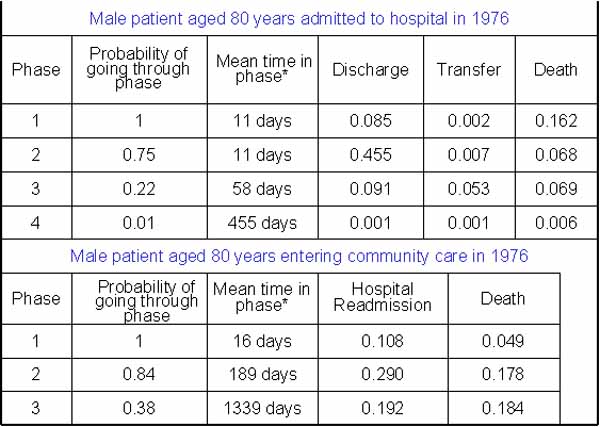Nosokinetics
Hands across the world: 21st Century Magic
Malcolm Faddy & Sally McClean
Step-by-step, two mathematics professors, Malcolm Faddy in Brisbane and Sally McClean in Northern Ireland have been unpacking the process of geriatric medical care [1]. The data they have been analysing is old. It was originally collected in 1976 on edge-punched cards. Their results are 21st Century computational magic.
Miracle of miracles, they have developed a computational method which demonstrates the phases of hospital and community care. The table below shows the outcome for males aged 80 years admitted by the Department of Geriatric Medicine at St. George’s Hospital, in London in 1976.
That year 969 patients were admitted. Their average was 80 years. Fifty-seven percent were admitted for the first time. At the end of the first week 13% had left by discharge, transfer or death. After five weeks (73%) had been discharged, at 10 weeks 88%, at 15 weeks 92%, by 20 weeks only 6% were still inpatients [2]. Seemingly, by magic and a series of, incomprehensible (to me) equations Malcolm and Sally they have calculated how these patients left.

The world population is ageing. Billions of pounds are being spent on the human genome project and stem cell research in the hope of health gains in future years. And millions of pounds are being spent on introducing electronic records and data collection. Yet, but little if any money is being spent by government on developing and introducing new computational methods of data analysis.
Wherever one looks, decisions are based on averages of skewed data. Little or no attention is given to the destination at discharge or to the outcome of inpatient care in terms of health gain for the patient.
The knowledge gap is immense. In the words of Prof Dan Dumitrescu at the Craiova conference “We must escape from Newtonian concepts of pressure and force and embrace complexity, to develop a more holistic view of health of social care.” Sally and Malcolm’s work is a “Giant step” in that direction. Three articles in this issue take up that theme.
1. Faddy, MJ, McClean SI Markov chain modelling for geriatric patient care. Methods of Information in Medicine 2005; 44:369-373.
2. Millard, P. H. (1989). Geriatric medicine: a new method of measuring bed usage and a theory for planning, MD thesis: University of London.
Some navigational notes:
A highlighted number may bring up a footnote or a reference. A highlighted word hotlinks to another document (chapter, appendix, table of contents, whatever). In general, if you click on the 'Back' button it will bring to to the point of departure in the document from which you came.Copyright (c)Roy Johnston, Peter Millard, 2005, for e-version; content is author's copyright,